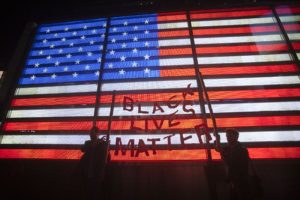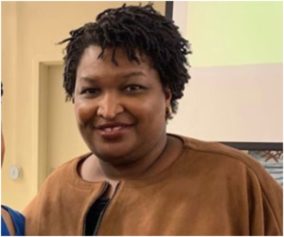 Black Lives Matter, Part II
Black Lives Matter, Part II
The Black Lives Matter movement can potentially reshape the national dialogue around race, class and the criminal justice system. It can also deepen the commitment of young and older grassroots leaders to racial justice and participatory democracy. This is the second part of a piece exploring how the movement can sustain itself.
What would have the potential to break new ground for 21st century resistance movements is a national gathering involving Black Lives Matter organizers and seasoned community organizations.
From organizations like the following: the Lost Voices, League of Young Voters, Black Lives Matter, Dream Defenders, BYP 100, Hands Up United, Center for Community Change, Organization for Black Struggle, Movement Strategy Center, Millennial Activists United, NAACP Youth & College Division, Malcolm X Grassroots Movement, Project South, Highlander Research and Education Center, National Coalition on Black Civic Participation, Ferguson Action, Southern Echo, and leading hip-hop activists.
However, a major concern is that some of the Black Lives Matter activists are caught up in what used to be called a “freedom high” and many actions — die-ins, hands-up postures and road blockades — lack strategic planning and are failing to tell real stories of how working people are adversely affected by the criminal justice system. Because some actions are ritualistic, some local initiatives or networks have done a poor job connecting the Ferguson and Staten Island grand jury decisions with local policy demands.
A national gathering could give the lead organizers the opportunity to strategize and think more systematically about leadership development, training and storytelling. It could give young people deeper connections with indigenous networks in working-class communities of color. It could encourage them to extend the organizing sphere to small cities and rural communities that are also plagued by police misconduct and racially disparate inequities in the criminal justice system. The gathering could also allow young people to link grievances about criminal justice irregularities to economic justice claims.
Admittedly, creating a national alliance has its shortcomings. It takes resources, funding, and the lead organizations would inevitably have to grapple with racial and ideological divisions in the Black Lives Matter movement. Yet, not having a national dialogue or gathering could damage the long-term prospects of youth activism.
Professor Matthew Countryman was a young organizer in the South African divestment movement during the 1980s. Similar to today’s protest wave, the divestment movement experienced an outpouring of student and young activists, who organized actions at more than 100 universities in the United States. The movement also pressured lawmakers to adopt the Comprehensive Anti-Apartheid Act of 1986, Congress’s most authoritative attack against the South African regime. Yet, as Countryman wrote in the Nation essay, “Beyond Victory: The Lessons of the Divestment Drive,” the movement “grounded to a halt largely because of serious organizational and strategic weaknesses.” Influential divestment activists religiously guarded their autonomy because of well-understood suspicions of co-optation. They then rejected attempts to build a broader political base or national alliance that could unite young activists and leverage the resources to extend movement building activities.
There is some indication that leading activists involved in Black Lives Matter are dialoguing about how to sustain the movement beyond the initial wave of actions. On Jan. 22, these activists coalescing under the moniker, National Collective of Black Organizers, released the report, “State of the Black Union: The Shadow of Crisis Has Not Passed.” The brief outlines 12 broad demands for America that reflect the sentiments of the Black Lives Matter movement.
However, 11 out of 12 demands mirror the resolutions and policy recommendations already advanced by mainline civil rights and black groups such as the NAACP, Urban League, National Action Network, Congressional Black Caucus, National Black Caucus of Local Elected Officials, National Black Caucus of State Legislators, and Nation of Islam. The only point of contention between the collective and mainline organizations is perhaps the former group’s critique of President Barack Obama’s My Brother’s Keeper initiative. The collective criticizes the exclusion of women and LGBT youth from the initiative, and instead urges Obama to reorganize it into the Our Children’s Keeper program. What’s missing from the brief is a detailed assessment of how the collective’s demands differ from those endorsed by pre-existing Black and civil rights groups. Also missing is a concrete plan that connects young activists with indigenous and older activists living in struggling Black communities, and working with residents who need immediate or specific policy interventions to address their material conditions.
Cross-sector Movement Alliances
In reality, the recent protests are part of a larger multi-layered and cross-sector protest wave. The Moral Monday movement initiated by the North Carolina NAACP has lasted a year and a half and is now in a dozen states. Another promising movement is the Show Me 15 — a $15 per hour wage for fast food workers — that has spread to 200 cities. Show Me 15 activists are mostly low-wage workers, people of color including a large representation of Black women, and young people. These worker activists offer a counter-narrative to the politics of respectability that positions students, middle-class or sanitized activists at the forefront of movement campaigns.
Fortunately, we can look to the Ferguson/St. Louis region to understand the benefits of cross-sector movement building. Some organizers on the frontlines of the restaurant boycotts in St. Louis joined the Ferguson protests. Some of the St. Louis/Ferguson worker activists then traveled to my home state of Tennessee to stand on the picket lines with boycotting fast-food workers. The cross-fertilization between criminal justice and economic justice movements is potentially one of the transformative outcomes of this current wave of protests.
Cross-sector alliances have already produced deeper conversations between diverse activists. They have allowed for movement borrowing or the sharing of strategies and tactics between different groups adversely affected by the “cradle-to-prison” regime, including Black youth activists concerned about racial profiling and racially based police killings, low-wage restaurant workers whose economic mobility is inhibited by prior histories in the criminal justice system, immigrant rights advocates who fight against racial profiling programs such as 287(g) that have led to the mass detention of undocumented residents, and young homeless rights activists whose constituents are heavily policed and pushed out of high-density and commercial development corridors.
The Role of the Academy
If Black Lives Matter, Moral Monday, Show Me 15, and other movements are going to be viable responses to inequality, then Black social scientists must be integral to this struggle. There are multiple roles that they (we) can play, including assisting young activists with press releases, op-eds, fundraising initiatives and research.
During the protest waves of the 1930s-1940s and the 1950s-1970s, there was a partnership between resistance movements and hybrid academicians (or scholars who had one foot in movements and the other one in the academy). Ira De Reid, E. Franklin Frazier and Charles Johnson belonged to a cadre of Black scholars commissioned by the American Council on Education in the 1940s to study the challenges facing Black youth. Their pioneering studies provided a broader context for shaping radical youth organizations such as the Southern Negro Youth Congress.
The National Conference of Black Political Scientists was also established in 1969 as an outgrowth of the civil rights and Black power movements. More recently, Black political scientists have been on the frontlines of anti-poverty and labor campaigns, movements to abolish the death penalty and reverse wrongful convictions, public health initiatives, LGBT movements, voting rights campaigns, and other social movements. The Moral Monday movement’s official training manual further encourages its state or local affiliates to partner with “activist scholars” as a key component of movement building.
The Current Flows
In looking back at the period that shaped Hubert Harrison’s perspective, one might very well conclude that he was wrong in his prediction that America was on the horizon of a Black fait accompli or permanent mode of Black resistance after World War I. Although Black students revolted at their universities in the 1920s, the protests were relegated to a small contingent of the middle-class. Harrison’s optimism notwithstanding, Jim Crow stiffened and Northern racism persisted. Racial terrorism also increased, and Black life worsened under the Great Depression.
The events in the first half of the 20th century underscore how difficult it is to sustain civil resistance beyond the initial outbursts or wave of protests. Ella Baker understood this challenge. She rejected the notion that the 1960 sit-in movement would continue to self-procreate even though the movement attracted tens of thousands of students.
After the initial wave of sit-ins, she and others rededicated themselves to organizing, planning, leadership development, intergenerational movement building and experimentation in order to convert youth insurgents into a formidable political force in the 1960s. As such, if the Black Lives Matter resistance is going to be a protracted struggle instead of an episodic one, its leading voices must follow Baker’s instructions. Only then will we know if the movement is the fait accompli for this generation.
Dr. Sekou Franklin is an Associate Professor in the Department of Political Science at Middle Tennessee State University (MTSU) and is the Coordinator of Urban Studies Minor Program at MTSU. He has published works on race and political opinion, urban politics, social movements and community organizing, juvenile justice, civil rights, the death penalty, youth activism, Venezuelan politics, and state and local politics. He is the author of After the Rebellion: Black Youth, Social Movement Activism and the Post-Civil Rights Generation (NYU Press, 2014) and has also served on the National Conference of Black Political Scientists’ Executive Committee.



